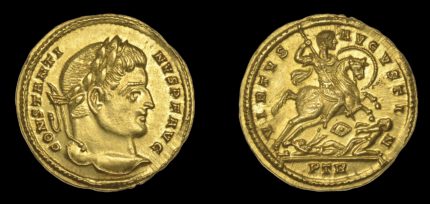An exceptional gold solidus of Emperor Constantine I, the first of its type ever discovered in Britain, will be sold at auction by the finder and landowner. It was discovered by a metal detector hobbyist in June of this year in Wanstrow, Somerset. June 7th was the first time he’d searched that field near an old Roman road. Wielding a second-hand metal detector, he first found a Roman brooch and some pieces of lead ore (the Roman road was used to transport lead from nearby mines). Then, a foot under the surface, he found a single gold coin.
Somerset Finds Liaison officers identified it as an extremely rare coin struck in Trier in ca. 313-15. The obverse features a laureate head of Constantine I facing right. It is inscribed CONSTANTI-NVS P[ius] F[elix] AVG[ustus] (“Constantine Pius and Blessed Revered One”).
The reverse depicts the emperor draped, cuirassed, with a spear in his right hand and a shield on his left arm. He rides a horse at the gallop against two enemy warriors, one trampled under the foot, the other about to be speared as he loses his shield. It is inscribed VIRTVS AUGSTI N(OSTRI) (“The valor of our Emperor”) and under the battle is the mint mark PTR which stands for Percussum Treveris, meaning “struck in Trier.”
Not only is this particular coin a unique find in Britain, only four gold coins from the Tetrarchy period (the system of four rulers, two Augusti, two Caesars, established by Domitian in 293 A.D.) have ever been found in Britain. Even more astonishing, the solidus is in near-mint uncirculated condition.
For comparison purposes, here’s an example of the same coin in one of the finest ancient coin collections in the world, the Münzkabinett of the Staatliche Museen zu Berlin. It has the same die axis alignment (in this case the alignment is 6 o’clock, meaning the reverse of the coin is upside down in relation to the obverse), but the Somerset coin is .42 grams heavier and .2 mm wider. It didn’t experience the wear and tear of circulation the way the Münzkabinett’s solidus did.
The solidus goes under the hammer on September 17th at Dix Noonan Webb. The pre-sale estimate is £10,000-£12,000 ($12,000-$14,500).
